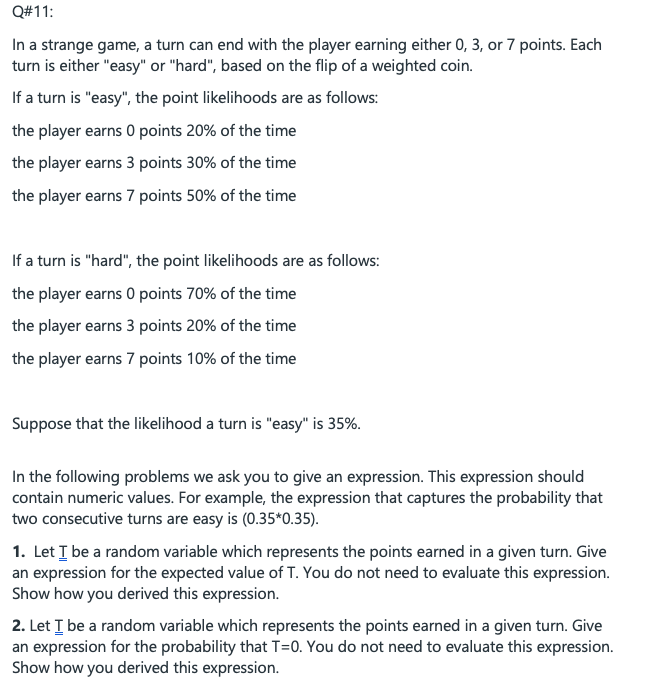In a strange game, a turn can end with the player earning either 0, 3, or 7 points. Each turn is either "easy" or "hard", based on the flip of a weighted coin. If a turn is "easy", the point likelihoods are as follows: the player earns 0 points 20% of the time the player earns 3 points 30% of the time the player earns 7 points 50% of the time If a turn is "hard", the point likelihoods are as follows: the player earns 0 points 70% of the time the player earns 3 points 20% of the time the player earns 7 points 10% of the time Suppose that the likelihood a turn is "easy" is 35%. In the following problems we ask you to give an expression. This expression should contain numeric values. For example, the expression that captures the probability that two consecutive turns are easy is (0.35*0.35). 1. Let I be a random variable which represents the points earned in a given turn. Give an expression for the expected value of T. You do not need to evaluate this expression. Show how you derived this expression. 2. Let I be a random variable which represents the points earned in a given turn. Give an expression for the probability that T=0. You do not need to evaluate this expression. Show how you derived this expression.
In a strange game, a turn can end with the player earning either 0, 3, or 7 points. Each turn is either "easy" or "hard", based on the flip of a weighted coin. If a turn is "easy", the point likelihoods are as follows: the player earns 0 points 20% of the time the player earns 3 points 30% of the time the player earns 7 points 50% of the time If a turn is "hard", the point likelihoods are as follows: the player earns 0 points 70% of the time the player earns 3 points 20% of the time the player earns 7 points 10% of the time Suppose that the likelihood a turn is "easy" is 35%. In the following problems we ask you to give an expression. This expression should contain numeric values. For example, the expression that captures the probability that two consecutive turns are easy is (0.35*0.35). 1. Let I be a random variable which represents the points earned in a given turn. Give an expression for the expected value of T. You do not need to evaluate this expression. Show how you derived this expression. 2. Let I be a random variable which represents the points earned in a given turn. Give an expression for the probability that T=0. You do not need to evaluate this expression. Show how you derived this expression.
Algebra & Trigonometry with Analytic Geometry
13th Edition
ISBN:9781133382119
Author:Swokowski
Publisher:Swokowski
Chapter10: Sequences, Series, And Probability
Section10.8: Probability
Problem 29E
Related questions
Concept explainers
Contingency Table
A contingency table can be defined as the visual representation of the relationship between two or more categorical variables that can be evaluated and registered. It is a categorical version of the scatterplot, which is used to investigate the linear relationship between two variables. A contingency table is indeed a type of frequency distribution table that displays two variables at the same time.
Binomial Distribution
Binomial is an algebraic expression of the sum or the difference of two terms. Before knowing about binomial distribution, we must know about the binomial theorem.
Topic Video
Question

Transcribed Image Text:Q#11:
In a strange game, a turn can end with the player earning either 0, 3, or 7 points. Each
turn is either "easy" or "hard", based on the flip of a weighted coin.
If a turn is "easy", the point likelihoods are as follows:
the player earns 0 points 20% of the time
the player earns 3 points 30% of the time
the player earns 7 points 50% of the time
If a turn is "hard", the point likelihoods are as follows:
the player earns 0 points 70% of the time
the player earns 3 points 20% of the time
the player earns 7 points 10% of the time
Suppose that the likelihood a turn is "easy" is 35%.
In the following problems we ask you to give an expression. This expression should
contain numeric values. For example, the expression that captures the probability that
two consecutive turns are easy is (0.35*0.35).
1. Let I be a random variable which represents the points earned in a given turn. Give
an expression for the expected value of T. You do not need to evaluate this expression.
Show how you derived this expression.
2. Let I be a random variable which represents the points earned in a given turn. Give
an expression for the probability that T=0. You do not need to evaluate this expression.
Show how you derived this expression.
Expert Solution
This question has been solved!
Explore an expertly crafted, step-by-step solution for a thorough understanding of key concepts.
Step by step
Solved in 4 steps with 4 images

Knowledge Booster
Learn more about
Need a deep-dive on the concept behind this application? Look no further. Learn more about this topic, probability and related others by exploring similar questions and additional content below.Recommended textbooks for you

Algebra & Trigonometry with Analytic Geometry
Algebra
ISBN:
9781133382119
Author:
Swokowski
Publisher:
Cengage

College Algebra
Algebra
ISBN:
9781305115545
Author:
James Stewart, Lothar Redlin, Saleem Watson
Publisher:
Cengage Learning

Algebra & Trigonometry with Analytic Geometry
Algebra
ISBN:
9781133382119
Author:
Swokowski
Publisher:
Cengage

College Algebra
Algebra
ISBN:
9781305115545
Author:
James Stewart, Lothar Redlin, Saleem Watson
Publisher:
Cengage Learning